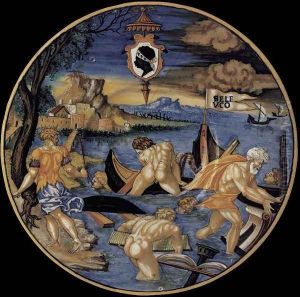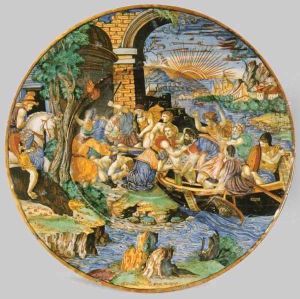Francesco Xanto Avelli Paintings
Francesco Xanto Avelli, born in Rovigo near Venice around 1486/1487 and died in 1542, was an enigmatic figure in the history of Italian Renaissance ceramics. He is renowned for his work in maiolica, a tin-glazed pottery that was popular during the Renaissance period. Although not much is known about his early life and training, Xanto became famous for his sophisticated and highly detailed painted ceramics, which were primarily produced in Urbino, a major center for maiolica production in the 16th century.
Xanto was unique among his contemporaries for his intricate narrative scenes, often drawn from classical mythology, Roman history, and contemporary literary sources, including the works of Petrarch and Ludovico Ariosto. His plates, vases, and ewers are notable for their vivid storytelling and the use of a rich, luminous palette that brought these narratives to life. Unlike many maiolica painters of his time, Xanto signed his works, allowing for a better understanding of his oeuvre and the extent of his influence.
His technique involved applying metallic oxides onto a white, opaque glaze that had been fired once; the painted object was then fired again to fuse the decoration with the glaze, creating a lustrous and durable surface. Xanto’s mastery of this process, coupled with his ability to depict complex scenes with depth and detail, set him apart from his peers.
Despite his obvious talent and contribution to the art of maiolica, Xanto's life and career were not without controversy. Some historical records suggest that he was involved in legal and financial disputes, and his innovative approach to maiolica decoration was sometimes criticized by contemporaries for deviating from traditional themes and styles. Nevertheless, Xanto's work was highly prized by patrons and collectors during his lifetime and has continued to be esteemed by art historians and collectors in the centuries since his death.
Today, Francesco Xanto Avelli is regarded as a pivotal figure in the development of Renaissance ceramic art. His works are held in major museums around the world, where they are celebrated for their artistic beauty and historical significance. Through his innovative use of glazing techniques and his narrative richness, Xanto contributed significantly to the evolution of maiolica, making it a true form of Renaissance art.

